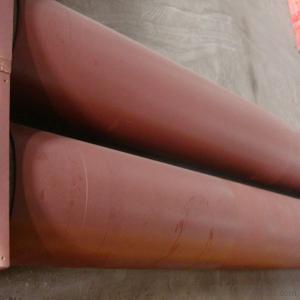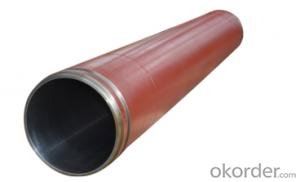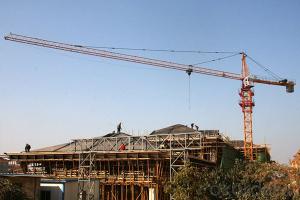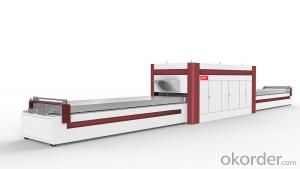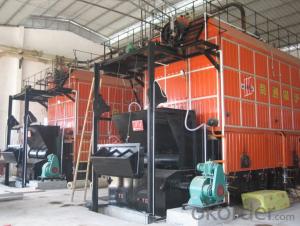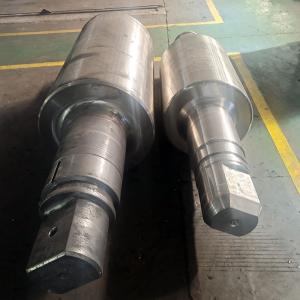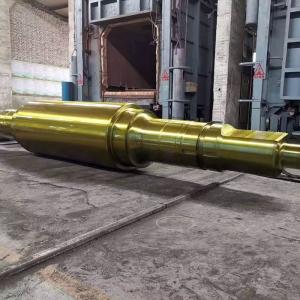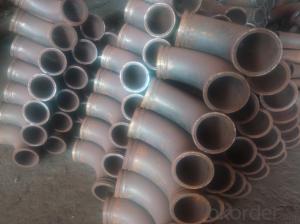Concrete Pumping Cylinder Model (PM) I.D.:DN230 X 2100MM
- Loading Port:
- Shanghai
- Payment Terms:
- TT OR LC
- Min Order Qty:
- 2 pc
- Supply Capability:
- 1000 pc/month
OKorder Service Pledge
OKorder Financial Service
You Might Also Like
Product Description:
The Concrete Pumping Cylinder Model (PM) I.D.:DN230 X 2100MM normally made by steel material No. C45. according to customer’s requests, and also package in bundles or nude packing directly put into container.
Scope of Application of the Cylinders
The Concrete Pumping Cylinder Model (PM) I.D.:DN230 X 2100MM is a concrete pumping for combined use with other concrete pumps in concrete pumping operations. It can be widely used in the construction of various types of concrete structures like industrial and civil buildings, bridges, roads, and other types of infrastructure.
This Concrete Pumping Cylinder Model (PM) I.D.:DN230 X 2100MM can only be used in concrete pump construction operations, but not in any other operations, like dragging, moving, or hoisting heavy articles or personnel. The pipe is also not allowed to be used in any location where any combustible or explosive material exists or a cave-in may occur.
Specifications:
Concrete Pumping Cylinder Model (PM) I.D.:DN230 X 2100MM
1. Life Span: 60,000~80,000cbm
2. Size: DN180, DN200, DN230..
4. Brand: PM
5. Material: Steel C45
6. Quenching and tempering to improve the hardness to HB241-280
7. Inner wall chrome thickness is 0.25-0.30mm, hardness HV820-900.
Product Advantages:
OKorder'sConcrete Pumping Cylinder Model (PM) I.D.:DN230 X 2100MM Channels are durable, strong, and safety.
Main Product Features:
· Premium quality
· Prompt delivery & seaworthy packing (10-20 days)
Reliable performance
Easy to weld
High safety.
· Professional Service
· Competitive pricing
Measuring of wall thickness from the outside
Low purchase cost
FAQ:
Q1: How long about delivery time about DN230*2100?
A1: Normally we keep the raw materials for old customers and sometime we also keep stock products to make sure delivery time in any emergency cases.
Q2: How do we guarantee the quality of our Cylinders DN230*2100?
A2: We have established an advanced quality management system which conducts strict quality tests at every step, from raw materials to the final product. At the same time, we provide extensive follow-up service assurances as required.
Q3: How soon can we receive the product after purchase?
A3: Within three days of placing an order, we will book the vessel for goods. The specific shipping date is dependent upon international and government factors, but is typically10 to 30 workdays.
Q4: If we can produce some Cylinders according to customers request?
A4: Yes, we can produce Cylinders according to the difference country situations to make it suitable to the market and customers. We have very professional technical team to make the design.
Q5: How to make a quick resolution for after service?
A5: OKorder and our manufacture both have overseas branches all-around of world, If needed,
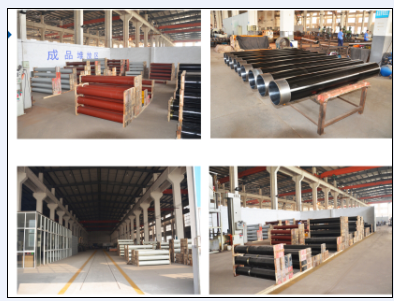
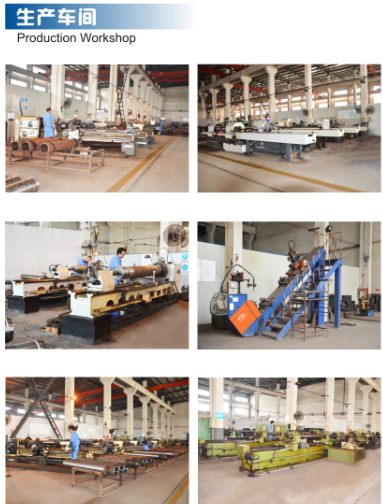
- Q:What is the purpose of a concrete pump agitator motor?
- The purpose of a concrete pump agitator motor is to mix and agitate the concrete mixture inside the pump, ensuring a consistent and homogenous blend. This helps to prevent the concrete from settling or segregating, ensuring a higher quality and more workable mixture for construction purposes.
- Q:What are some common issues with concrete pump pipes and how can they be prevented?
- Some common issues with concrete pump pipes include blockages, leaks, and wear and tear. These issues can be prevented by following proper maintenance and operational practices. 1. Blockages: Blockages occur when concrete hardens inside the pipe, hindering the flow. To prevent blockages, it is important to regularly clean the pipes after each use. Flushing the pipes with water or using a high-pressure air hose can remove any residual material and prevent build-up. Additionally, using concrete mixtures with proper consistency and avoiding excessive use of additives can reduce the likelihood of blockages. 2. Leaks: Leaks can occur due to cracks or gaps in the pipe, causing concrete to seep out. Regular inspection of the pipes is crucial to identify any signs of damage or wear. Repairing or replacing damaged sections promptly can prevent leaks. It is also essential to use high-quality pipes that are resistant to abrasion and chemical corrosion, as they are less prone to developing leaks. 3. Wear and Tear: Concrete pump pipes are subjected to significant stress and abrasion during operation. Over time, this can lead to wear and tear, resulting in weakened pipes or even breakages. To prevent excessive wear, it is important to use pipes made from durable materials such as hardened steel or composite materials. Regularly inspecting the pipes for signs of wear, such as thinning or deformation, and replacing them as needed can help prevent sudden failures. 4. Pipe movement and alignment issues: Concrete pump pipes can shift or become misaligned during operation, leading to reduced efficiency and potential damage. To prevent this, ensure that the pipes are securely fastened to the pump and properly aligned. Using clamps and brackets or employing anti-vibration measures can help maintain the stability and alignment of the pipes during pumping operations. 5. Operator errors: Improper handling and operation can also contribute to issues with concrete pump pipes. Operators should be adequately trained in operating the pump and handling the pipes. Following recommended operating procedures, avoiding excessive pressure or flow rates, and being cautious while maneuvering the pipes can prevent unnecessary strain and damage to the pipes. Overall, proactive maintenance, proper handling, and selecting high-quality pipes can significantly reduce common issues with concrete pump pipes, ensuring smooth and efficient concrete pumping operations.
- Q:How does a concrete pump agitator motor prevent concrete from settling?
- A concrete pump agitator motor prevents concrete from settling by constantly agitating the mixture. The motor is typically equipped with paddles or blades that rotate inside the mixing drum, ensuring that the concrete remains in a homogeneous state. When concrete is being transported, it tends to separate due to gravity and the natural settling of heavier aggregates. This can result in a non-uniform consistency, with denser materials sinking to the bottom and water rising to the top. The agitator motor counteracts this settling process by continuously stirring the concrete. The rotating paddles or blades create a turbulent flow within the mixing drum, preventing the heavier aggregates from settling and maintaining a consistent mixture. This agitation helps to evenly distribute the cement, aggregates, water, and any additional additives throughout the concrete, resulting in a more uniform and reliable end product. By preventing the settling of concrete, the agitator motor ensures that the mixture is consistently workable and can be pumped or poured without any blockages or inconsistencies. This is especially crucial during construction projects where precise and consistent concrete placement is required. In summary, a concrete pump agitator motor prevents settling by agitating the mixture, keeping it homogeneous and ensuring a consistent flow during pumping or pouring operations.
- Q:How often should concrete pump lubrication systems be inspected and maintained?
- Concrete pump lubrication systems should be inspected and maintained regularly to ensure their proper functioning and longevity. The frequency of inspections and maintenance will depend on various factors such as the type of pump, its usage, and the manufacturer's recommendations. Generally, it is recommended to inspect and maintain concrete pump lubrication systems on a monthly basis. This allows for early detection of any potential issues or wear and tear that may require attention. Additionally, regular inspections can help identify any signs of lubricant degradation or contamination, which can impact the efficiency and performance of the system. During the inspection, it is important to check for any leaks, damaged or worn-out components, and ensure that all lubrication points are properly greased. The lubrication system should also be cleaned to remove any debris or contaminants that may have accumulated over time. In addition to monthly inspections, certain maintenance tasks should be performed at regular intervals. This may include changing the lubricant and filters, adjusting or replacing belts and hoses, and checking the system for proper pressure and flow. It is important to note that the manufacturer's guidelines and recommendations should always be followed when it comes to inspecting and maintaining concrete pump lubrication systems. They may provide specific instructions based on the type and model of the pump, as well as any unique requirements. By regularly inspecting and maintaining concrete pump lubrication systems, you can ensure their optimal performance, minimize downtime, and extend their lifespan.
- Q:How does a hopper agitator blade ensure smooth concrete flow?
- To guarantee a seamless flow of concrete, a hopper agitator blade is employed to mix and disintegrate any clumps or air pockets in the concrete mixture. Specifically designed to be positioned inside the hopper, the blade rotates and agitates the concrete, ensuring a homogeneous and steady state. While in rotation, the blade disperses any settled aggregates at the hopper's base, preventing blockages or uneven distribution during the pouring procedure. This uninterrupted mixing action guarantees that the concrete remains well-blended and effortlessly pours out of the hopper. Furthermore, the agitator blade aids in breaking up any air bubbles that may have formed within the concrete mixture. These air bubbles can compromise the structural integrity of the concrete and lead to an uneven final appearance. By agitating the concrete, the blade effectively releases trapped air, promoting a consistently dense mixture. In essence, a hopper agitator blade guarantees a seamless flow of concrete by effectively blending the mixture, breaking apart any clumps or air pockets, and fostering a uniform composition. This ensures that the concrete pours smoothly and evenly during the pouring process, resulting in a top-notch end product.
- Q:How can a faulty concrete pump control valve affect the pumping operation?
- A faulty concrete pump control valve can have several negative effects on the pumping operation. Firstly, it can cause a loss of control over the concrete flow rate. The control valve is responsible for regulating the amount of concrete being pumped, and if it is faulty, it may not be able to properly adjust the flow rate. This can lead to either too much or too little concrete being pumped, which can result in an inefficient operation. Secondly, a faulty control valve can cause inconsistent concrete flow. The valve is designed to maintain a steady and consistent flow of concrete, but if it is not functioning properly, it may result in fluctuations in the flow. This can lead to uneven distribution of the concrete, which can affect the quality and integrity of the pumped concrete. Furthermore, a faulty control valve can also contribute to increased wear and tear on the pump and other components. When the valve is not operating correctly, it can cause excessive pressure or strain on the pump, leading to increased wear on the equipment. This can result in more frequent breakdowns or the need for repairs, which can be costly and time-consuming. Overall, a faulty concrete pump control valve can significantly impact the pumping operation by causing a loss of control over the flow rate, inconsistent concrete flow, and increased wear and tear on the equipment. It is important to regularly inspect and maintain the control valve to ensure its proper functioning and avoid these negative consequences.
- Q:How do I maintain the performance of concrete pump spare parts in extreme weather conditions?
- To maintain the performance of concrete pump spare parts in extreme weather conditions, it is crucial to take certain precautions. Firstly, ensure that the spare parts are properly protected from direct exposure to harsh weather elements such as rain, snow, or extreme heat. This can be achieved by using covers or shelters to shield the parts. Additionally, regular cleaning and lubrication of the spare parts will help to prevent any buildup of dust, dirt, or moisture that could potentially affect their performance. Lastly, conducting regular inspections and maintenance checks will allow for early detection of any damage or wear, enabling timely repairs or replacements to be made, thus ensuring optimal performance in extreme weather conditions.
- Q:What is the purpose of a concrete pump hydraulic accumulator bladder?
- The purpose of a concrete pump hydraulic accumulator bladder is to store and release hydraulic energy, resulting in smoother and more efficient operation of the concrete pump.
- Q:How often should concrete pump control boxes be inspected and replaced?
- To maintain proper functioning and safety, it is essential to regularly inspect the control boxes of concrete pumps. The frequency of inspections and replacements will vary depending on factors such as pump usage, operating conditions, and manufacturer recommendations. In general, it is advisable to inspect the control box at least once a year or according to the manufacturer's guidelines. However, if the concrete pump is extensively used or exposed to harsh conditions, more frequent inspections may be needed. This involves checking electrical connections, switches, buttons, and indicators for signs of wear, damage, or malfunction. Moreover, inspections should be conducted after significant maintenance or repairs on the pump, as well as following any incidents or accidents. Regular inspections allow for early identification of potential issues, enabling timely repairs or replacements and reducing the risk of breakdowns or accidents. When it comes to replacements, control boxes should be replaced if they cannot be repaired or if they are outdated and no longer meet safety standards. It is important to consult the manufacturer or a qualified professional to determine the appropriate replacement schedule based on the specific conditions and usage of the concrete pump. Always remember, regular inspections and timely replacements of concrete pump control boxes are essential for ensuring the safe and efficient operation of the equipment.
- Q:How to calculate the power of concrete pump motor?
- Second, the amount of transport is the amount of export pressure is determined,
1. Manufacturer Overview |
|
|---|---|
| Location | |
| Year Established | |
| Annual Output Value | |
| Main Markets | |
| Company Certifications | |
2. Manufacturer Certificates |
|
|---|---|
| a) Certification Name | |
| Range | |
| Reference | |
| Validity Period | |
3. Manufacturer Capability |
|
|---|---|
| a)Trade Capacity | |
| Nearest Port | |
| Export Percentage | |
| No.of Employees in Trade Department | |
| Language Spoken: | |
| b)Factory Information | |
| Factory Size: | |
| No. of Production Lines | |
| Contract Manufacturing | |
| Product Price Range | |
Send your message to us
Concrete Pumping Cylinder Model (PM) I.D.:DN230 X 2100MM
- Loading Port:
- Shanghai
- Payment Terms:
- TT OR LC
- Min Order Qty:
- 2 pc
- Supply Capability:
- 1000 pc/month
OKorder Service Pledge
OKorder Financial Service
Similar products
New products
Hot products
Related keywords
